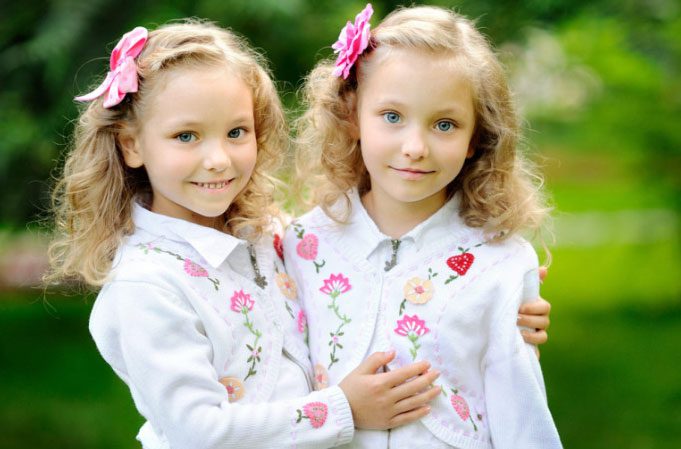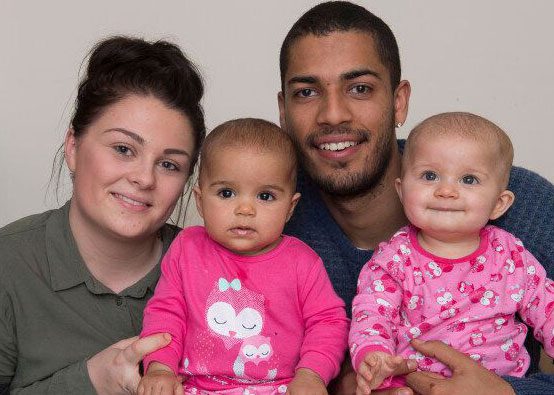Typically, each baby in a set of twins or triplets is born just a few minutes apart, but sometimes they can be born a week or even several weeks apart. Some twins look exactly alike, while others can be quite different… Why is that?
Essential Facts About Twin Births
Typically, humans give birth to one child during each pregnancy, but there are cases of twins, triplets, quadruplets, or even more. These instances are referred to as multiple births.
Identical Twins vs. Fraternal Twins

Typically, twins appear as if they are “photocopies” of each other, identical in skin color, facial features, hair type, and even gender – (Image: GreenArea)
An embryo is formed when a single egg is fertilized by a single sperm, creating a zygote. The zygote will develop into an embryo and form a baby in the mother’s womb.
However, during fertilization, if two eggs are fertilized by two different sperm, resulting in two embryos developing simultaneously in the womb, this is referred to as fraternal twins.
If one egg and one sperm fertilize but split into two completely independent zygotes, this is known as identical twins.
Twins with Different Fathers
Typically, during each menstrual cycle, a woman releases one egg; however, there are cases where two or three eggs are released. If two of these eggs are fertilized by sperm from two different men, this phenomenon is known as twins with different fathers.
Science refers to these cases as “superfetation,” although the occurrence is extremely rare. Since 2011, there have been fewer than ten recorded cases worldwide. In Vietnam, a similar case was reported in a couple from Hoa Binh in 2016 when the father noticed that his twin daughters did not look alike and requested DNA testing.
Twins with Different Skin Colors
This case is also referred to as “superfetation,” with a very low occurrence rate and typically happens in families with parents from different ethnic backgrounds, such as a father of African descent (curly hair, dark skin) and a mother of Asian (yellow skin, black hair) or European (light skin, blonde hair) descent.
When one or two of the mother’s eggs are fertilized to create two embryos, each baby inherits a different combination of genes from both parents. Therefore, when parents belong to different ethnicities, the inherited genes for skin color can vary.
Identical Twins vs. Fraternal Twins
The differences between individuals are determined by genes. Each child is born with a set of genes composed of half from the mother and half from the father. This is why each of us is born with traits from both parents, never being “just like the father” or “just like the mother.”
Identical twins occur only when they come from the same egg. This means one egg is fertilized and splits into two embryos, sharing identical genes. In this case, they are called monozygotic twins. The babies born will look as if they are “photocopies” of each other, identical in skin color, facial features, hair type, and even gender. Monozygotic twins will only be born as two males or two females.
In contrast, if two eggs are fertilized by two sperm from the father, they will create fraternal twins. Fraternal twins will have a lower genetic similarity, comparable to that of regular siblings without sharing the same genes as identical twins. The babies will have slight differences in skin tone, eye color, and hair type.
This is also why there can be pairs of male twins or female twins, as well as male-female twins.

If parents belong to two different ethnicities, they may give birth to twins who do not resemble each other in skin color – (Image: Manchester Evening News)
Twins Not Conceived on the Same Day
Science refers to this as the phenomenon of “pregnancy while pregnant.”
According to medical studies, there are three phenomena that can occur at the moment a woman begins her pregnancy.
- First: The body stops ovulating. In normal cases, one ovary releases an egg during each menstrual cycle. However, this does not occur when the egg meets sperm. At that point, the woman begins her pregnancy, and her body releases hormones to prevent further ovulation.
- Second: Sperm has a harder time “swimming” inside. As soon as an egg is fertilized, more mucus accumulates in the cervical canal, forming a “plug” that blocks the movement of sperm inside.
- Third: The uterus only has room for one embryo. When an embryo is formed in the uterus, a miraculous biological mechanism occurs in the woman’s body, and immediately the uterus “prevents” another embryo from implanting there.
If all these factors do not occur simultaneously or do not occur at all, two pregnancies can happen at the same time, but the result will be that the fetuses will be at different stages of development.
Twins with Different Birthdays
Typically, each baby in a set of twins or triplets is born just a few minutes apart. However, medical records worldwide have documented many cases of twins born a week or even several weeks apart. These cases are considered extremely rare in human reproduction.
A case of twins born on different days occurs when the mother gives birth prematurely. After that, doctors can intervene medically to temporarily halt labor and keep the remaining fetus in the mother’s womb to develop until full term.
Additionally, an interesting reason for twins to have different birthdays, even different years, is when the mother goes into labor and gives birth at midnight, with one baby born just before midnight and the second baby born in the first minutes of the new day or the new year.





















































